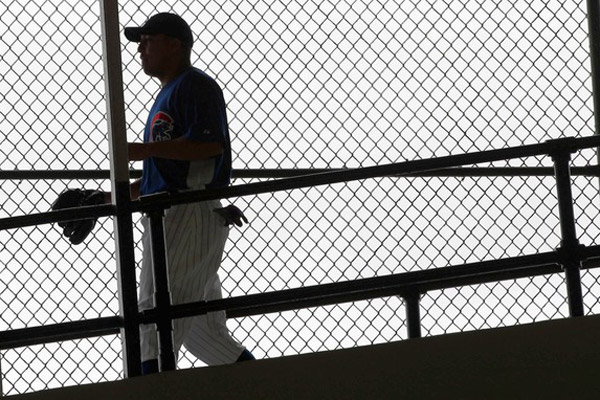
The Carlos Zambrano era is over, with the Cubs eating $15 (or $15.5) million of the $18 million their veteran starter is owed in 2012 so they could finally be rid of the irreparable relationship. Phil Rogers is excited, but I'm kind of depressed; for years Zambrano's off-field (or at least in-dugout) drama was matched with impressive consistency on the mound, at least until the past couple years, when everything went south. In some ways, Zambrano was a good compliment to his new Marlins teammate Mark Buehrle, a well-above-average pitcher with matchless reliability. That things went so sour the Cubs had to pay the Marlins to take him off their hands is a bit sad, though the team had little choice but to do so.
But it's not just a personality dump. The Cubs ex-Rated Rookie Chris Volstad, a tall drink of water and an intriguing flier. And, as Chris Cwik argues, Volstad, right now, may be as good a pitcher as Zambrano… if you ignore his ERA:
Volstad might not strike out many batters, but he limits walks much better than Zambrano. Volstad hasn’t been the most durable pitcher, either — but he’s still thrown 60-plus more innings than Zambrano during the past two seasons. Their ERAs might not show it, but Volstad has been nearly as good since 2010. Zambrano’s lead in FIP is a slim 4.17 to 4.33, and Volstad actually posted a superior xFIP (4.05) in that period.
Which puts him in good company among the loveable losers:
Volstad’s ability to outperform his ERA points to a trend for Cubs pitchers this upcoming season. All five of the Cubs’ current starters — Volstad, Travis Wood, Randy Wells, Ryan Dempster and Matt Garza — posted stronger xFIPs when compared to their ERAs.
FIP is Fielding Independent Pitching; xFIP is FIP without the hard-to-predict home-run-rate variable. The idea is that Volstad has more immediate talent than his recent history would indicate, and he has a tendency to show up on lists of hard-luck pitchers. In late October, Jeff Zimmerman put together a list of the luckiest and unluckiest pitchers in the major leagues, comparing their results on the season with the numbers you might expect from their performance. Two Cubs made the list of part-time starters: Randy Wells, fourth from the bottom, and Chris Volstad, tied for the unluckiest starter in baseball.
In August, when Volstad had a mind-bending 5.70 ERA (thanks to his 8.50 ERA in the month of June), Volstad was the number-one SIERA underperformer in baseball, ahead of even John Lackey's infamous 2011 season (a 5.01 August ERA and 2.32 September-October ERA brought Volstad back down to earth). SIERA is skill-interactive ERA, a formula meant to determine "the underlying skill level of this pitcher." And even in the midst of his awful season, Volstad showed signs of improvement, even if they were canceled out by "luck."
The argument behind of all these numbers that you won't find on the back of your baseball card is that Volstad really can't be any worse than he was in 2011, and is likely to be better, if not great. Meanwhile, Zambrano has declined considerably since 2006, perhaps as a result of all the extremely good innings he through when he was a young pitcher. So think of it this way: instead of wildly overpaying for one toxic, slightly above-replacement pitcher on the decline, they're overpaying slightly less for one non-toxic, slightly above-replacement pitcher who has the potential to be just as good or better than Zambrano, and a potential future bargain once the Zambrano golden-parachute money is off the books. Or: the angriest pitcher in baseball for the unluckiest.
Photograph: Chicago Tribune



